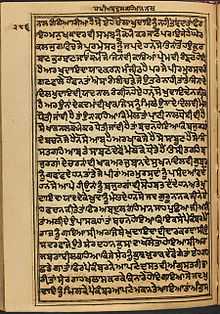Janamsakhis
| This article is part of a series on |
| Sikhism |
|---|
 |
|
Sikh Bhagats
|
|
Philosophy |
|
List
|
|
Sikhism portal Indian religions portal |
The Janamsakhis (Punjabi: ਜਨਮਸਾਖੀ, janamsākhī), literally birth stories, are writings which profess to be biographies of the first Sikh guru, Guru Nanak. These compositions have been written at various stages after the death of the first guru.
Overview
All the Janamsakhis record miraculous acts and supernatural conversations. Many of them contradict each other on material points and some have obviously been touched up to advance the claims of one or the other branches of the Guru's family, or to exaggerate the roles of certain disciples. Macauliffe compares the manipulation of janamsakhs to the way gospels were also in early Christian Church:
"Vast numbers of spurious writings bearing the names of apostles and their followers, and claiming more or less direct apostolic authority, were in circulation in the early Church - Gospels according to Peter, to Thomas, to James, to Judas, according to the Apostles, or according to the Twelve, to Barnabas, to Matthias, to Nicodemus, & co.; and ecclesiastical writers bear abundant testimony to the early and rapid growth of apocryphal literature. - Supernatural Religion, vol.i, p.292.
The falsification of old or the composition of new Janamsakhis were the result of three great schisms of the Sikh religion: The Udasis, the Minas and the Handalis.
Though from the point of view of a historian the janamsakhis may be inadequate, they cannot be wholly discarded because they were based on legend and tradition which had grown up around the Guru in the years following his physical passing away, and furnish useful material to augment the bare but proved facts of his life. The main janamsakhis which scholars over the years have referred to are as follows:
Main Janamsakhis
Bhai Bala Janamsakhi
This is probably the most popular and well known Janamsakhi, in that most Sikhs and their Janamsakhi knowledge comes from this document. This work claims to be a contemporary account written by one Bala Sandhu in the Vikram Samvat year 1592 at the instance of the second Guru, Guru Angad. According to the author, he was a close companion of Guru Nanak and accompanied him on many of his travels. There are good reasons to doubt this contention:
- Guru Angad, who is said to have commissioned the work and was also a close companion of the Guru in his later years, was, according to Bala's own admission, ignorant of the existence of Bala.
- Bhai Gurdas, who has listed all Guru Nanak's prominent disciples whose names were handed down, does not mention the name of Bhai Bala Sandhu. (This may be an oversight, for he does not mention Rai Bular either.)
- Bhai Mani Singh's Bhagat Ratanwali, which contains essentially the same list as that by Bhai Gurdas, but with more detail, also does not mention Bala Sandhu.
- It is only in the heretic janamsakhis of the Minas that we find first mention of Bhai Bala.
- The language used in this janamsakhi was not spoken at the time of Guru Nanak or Guru Angad, but was developed at least a hundred years later.
- Some of the hymns ascribed to Nanak are not his but those of the second and fifth Gurus.
- At several places expressions which gained currency only during the lifetime of the last Guru, Guru Gobind Singh (1666-1708), are used e.g. Waheguru ji ki Fateh. Bala's janamsakhi is certainly not a contemporary account; at best it was written in the early part of the 18th Century.
This janamsakhi has had an immense influence over determining what is generally accepted as the authoritative account of Guru Nanak Dev Ji’s life. Throughout the nineteenth century the authority of the Bala version was unchallenged. An important work based on the Bhai Bala janam-sakhi is Santokh Singh’s Gur Nanak Purkash commonly known as Nanak Parkash. Its lengthy sequel, Suraj Parkash carries the account up to the tenth Guru and contains a higher proportion of historical fact, this was completed in 1844.
In the first journey or udasi Guru Nanak Dev Ji left Sultanpur towards eastern India and included, in the following sequence : Panipat (Sheikh Sharaf), Delhi (Sultan Ibrahim Lodi), Hardwar, Allahbad, Banaras, Nanakmata, Kauru, Kamrup in Assam (Nur Shah), Talvandi (twelve years after leaving Sultanpur), Pak Pattan (Sheikh Ibrahim), Goindval, Lahore and Kartarpur.
The Second udasi was to the south of India with companion Bhai Mardana. Delhi, Ayodhya, Jagannath Puri, Rameswaram, Sri Lanka, Vindhya mountains, Narabad River, Ujjain, Saurashtra and Mathura
The third udasi was to the north : Kashmir, Mount Sumeru and Achal
The fourth udasi was to the west. Afghanistan, Persia, and Baghdad
Vilayat Vali Janamsakhi
In the year 1883 a copy of a janamasakhi was dispatched by the India Office Library in London for the use of Dr.Trumpp and the Sikh scholars assisting him. (It had been given to the library by an Englishman called Colebrook; it came to be known as the Vilayat Vali or the foreign janamsakhi.) This janamsakhi was the basis of the accounts written by Trumpp, Macauliffe, and most Sikh scholars. It is said to have been written in 1588 AD by one Sewa Das.
Hafizabad Vali Janamsakhi
A renowned Sikh scholar, Gurmukh Singh of the Oriental College, Lahore, found another janamsakhi at Hafizabad which was very similar to that found by Colebrook. Gurmukh Singh who was collaborating with Mr. Macauliffe in his research on Sikh religion, made it available to the Englishman, who had it published in November 1885. This biography agrees entirely with the India Office janamsakhi.
Bhai Mani Singh’s Janamsakhi

The fourth and eveidently the latest is the Gyan-ratanavali attributed to Bhai Mani Singh who wrote it with the express intention of correcting heretical accounts of Guru Nanak Dev Ji. Bhai Mani Singh was a Sikh of Guru Gobind Singh Ji. He was approached by some Sikhs with a request that he should prepare an authentic account of Guru Nanak Dev Ji’s life. This they assured him was essential as the Minas were circulating objectionable things in their version. Bhai Mani Singh referred them to the Var of Bhai Gurdas Ji, but this, they maintained was too brief and a longer more fuller account was needed. Bhai Mani Singh writes :
Just as swimmers fix reeds in the river so that those who do not know the way may also cross, so I shall take Bhai Gurdas’s var as my basis and in accordance with it, and with the accounts that I have heard at the court of the tenth Master, I shall relate to you whatever commentary issues from my humble mind. At the end of the Janam-sakhi there is an epilogue in which it is stated that the completed work was taken to Guru Gobind Singh Ji for his seal of approval. Guru Sahib Ji duly signed it and commended it as a means of acquiring knowledge of Sikh belief.
Other Janamsakhis
Many other janamsakhis have since been discovered. They follow the above two in all material points. The famous historian, Karam Singh, mentions half a dozen he came across in his travels.
The term Puratan janamsakhis means ancient janam-sakhis and is generally used with reference to the composite work which was compiled by Bhai Vir Singh and first published in 1926. Of the still existing copies of the Puratan Janam-sakhis the two most important were the Colebrooke and Hafizabad versions. The first of these was discovered in 1872, the manuscript had been donated to the library of the east India company by H.T. Colebrooke and is accordingly known as the Colebrooke or Vailaitwali Janamsakhi. Although there is no date on it the manuscript points to around 1635.
According to the Puratan Janamsakhi, Guru Nanak Dev Ji was born in the month of Vaisakh, 1469. The date is given as the third day of the light half of the month and the birth is said to have taken place during the last watch before dawn. His father Kalu was a khatri of the Bedi sub-cast and lived in a village Rai Bhoi di Talwandi; his mother's name is not given. When Guru Ji turned seven he was taken to a pundit to learn how to read. After only one day he gave up reading and when the pundit asked him why Guru Ji lapsed into silence and instructed him at length on the vanity of worldly learning and the contrasting value of the Divine Name of God. The child began to show disturbing signs of withdrawal from the world. He was sent to learn Persian at the age of nine but returned home and continued to sit in silence. Locals advised his father that Nanak should be married. This advice was taken and at the age of twelve a betrothal was arranged at the house of Mula of the Chona sub-caste. Sometime later Nanak moved to Sultanpur where his sister Nanaki was married. Here he took up employment with Daulat Khan. One day Nanak went to the river and while bathing messengers of God came and he was transported to the divine court. There he was given a cup of nectar (amrita) and with it came the command “ Nanak, this is the cup of My Name (Naam). Drink it.” This he did and was charged to go into the world and preach the divine Name.
The Miharban Janam-sakhi
Of all the manuscripts this is probably the most neglected as it has acquired a disagreeable reputation. Sodhi Miharban who gives his name to the janam-sakhi was closely associated with the Mina sect and the Minas were very hostile towards the Gurus around the period of Guru Arjan Dev Ji. The Minas were the followers of Prithi Chand the eldest son of Guru Ram Das Ji. Prithi Chand's behaviour was evidently unsatisfactory as he was passed over in favour of his younger brother, (Guru) Arjan Dev, when his father chose a successor. The Minas were a robber tribe and in Punjabi the word has come to mean someone who conceals his true evil intent. The Minas were subsequently execrated by Guru Gobind Singh Ji and Sikhs were instructed to have no dealings with them. The sect is now extinct. It is said that it was due to this janam-sakhi and its hostility towards the Gurus that prompted Bhai Gurdas Ji’s account and the commission of the Gyan-ratanavali.
The first three sakhis recount the greatness of Raja Janak and describes an interview with God wherein Raja Janak is instructed that he is to return to the world once again to propagate His Name. Details of Guru Nanak’s birth are given in the fourth sakhi and his father was Kalu, a Bedi and his mother Mata Tripta. The account of Guru Ji learning to read from the pundit is also recounted here. After the interlude at Sultanpur Guru Nanak Dev Ji set out to Mount Sumeru. Climbing the mountain Guru Ji found all nine Siddhas seated there – Gorakhnath, Mechhendranath, Isarnath, Charapatnath, Barangnath, Ghoracholi, Balgundai, Bharathari and Gopichand. Gorakhnath asked the identity of the visitor and his disciple replied, “ This is Nanak Bedi, a pir and a bhagat who is a householder.” What follows is a lengthy discourse with the siddhas which ends with the siddhas asking what is happening in the evil age of Kali Yuga. Guru Ji responds with three sloks :
There is a famine of truth, falsehood prevails, and in the darkness of kaliyug men have become ghouls ..1
The kaliyug is a knife, kings are butchers, dharama has taken wings and flown .....2
Men give as charity the money they have acquired by sinful means .......3
Manuscripts
References
- Macauliffe, M.A (1909). The Sikh Religion: Its Gurus Sacred Writings and Authors. Low Price Publications. ISBN 81-7536-132-8.
- Singh, Khushwant (1963). A History of the Sikhs: 1469-1839 Vol.1 (2nd ed.). Oxford University Press. ISBN 0-19-567308-5.
| ||||||||||||||||||||||||||||||||||